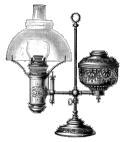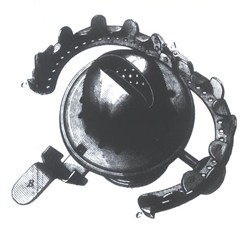While doing some microfilm research at the Newburgh Free Library a few years ago, I ran across the following entry in the April 25, 1868 edition of The Scientific American. To my knowledge, a burner utilizing this rather unique form of chimney attachment has not been produced. I could not find any patents issued to the petitioner, T.T. Roup. I was able to locate the 1850 Federal Census entry for Thomas Roup in Warren County, Kentucky. He is listed as being 25 years of age and his occupation is listed as "laborer." Thomas T. Roup was born in Ohio and of German descent. He married Eliza J. Higgins, a Pennsylvania native of Irish descent. They had one daughter, Alice D. Roup born on October 28, 1854 in Warren County, Kentucky. I located a miscellaneous entry regarding licensing to sell spirits and liquor in Warren County, Kentucky in 1860 to Thos. T. Roup, and in 1862 to T.T. Roup. These are likely all the same person.
|

| Reference Desk | Lamp Information | Other Resources | On-Line Shopping |

Purveyors of Antique Lighting and Accessories
435 Main Street
 Hurleyville, New York 12747
Hurleyville, New York 12747
was this burner ever made?

The ROUP Burner
^ Top of Page
Privacy Policy | Terms and Conditions of Use | Announcements
Copyright © 2001-2011 ~ Daniel Edminster | The Lampworks ~ All Rights Reserved
